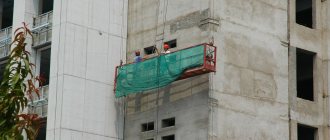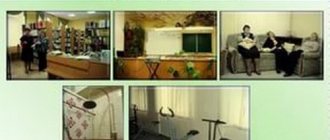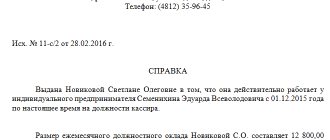The workplace description is not an official document, but it is quite often in demand in personnel records management. It may be required for an employee to register a disability or when drawing up a workplace design. In different situations, a document may have its own drafting features. However, there is no approved form of such a document and companies can independently develop it and approve it in their local regulatory documents. In the article we will look at why a workplace profile is needed, how to compile it, and also provide a sample of it.
What is a workplace characteristic?
The characteristics of the workplace is a document that is drawn up according to the conditions of production activities. Such a document may be required if it is necessary for an employee to undergo a medical examination to establish a disability, in the case of students undergoing certification, or when improving the qualifications of employees . Despite the fact that such a concept as “workplace characteristics” is not used in regulatory legal acts, it can be found quite often in regional or industry-specific regulatory documents.
When is a workplace characteristic needed?
If an employee requires an expert assessment to determine the degree of disability or to determine incapacity, as well as to establish disability, then a certificate describing his workplace may be required. In addition, this document may also be needed when certifying an employee, or in the case of personnel selection. Also, characterization of working conditions can be useful in internal office work. In this case, the document contains information about the employees’ personal workplaces, as well as about the collective workplace. The certificate describes the workplace in some detail, as well as its location and equipment (
Filling in, if not all places had SOUT
Note! At the beginning of the year, the employer must fill out a new form in Form 4-FSS.
Table No. 5 indicates the data on the inspection performed at the beginning of the new year. During the year, the head of the company may not change the data entered into the table. But when submitting a reporting declaration at the end of each quarter, the head of the company must also enter this table into the form. It turns on even if a re-check has not been carried out.
It’s easy to calculate the total number of jobs of the policyholder and fill out table No. 5 in form 4-FSS. The main thing is that the owner of the enterprise correctly enters all the information into the downloaded form and submits all documents to the Federal Tax Service on time. But most often, employees of the regulatory body independently point out errors to the user and help him fill out reports and tables.
How is the workplace described?
The workplace description is free-form, but when drawing it up, you should follow the rules of personnel records management . The certificate is issued on company letterhead and contains the following:
| Details of the characteristics from the place of work | What is indicated |
| Employer information | The organizational and legal form of the company, its name and registration address. The actual address of the company may also be indicated. |
| Employee information | Passport details, employee position, work experience |
| Information about the nature of the work | Information is provided that reflects the load on the employee’s musculoskeletal system, as well as its other functional systems. |
| Work time | Duration of the working day, including the number and time of breaks |
| Hygienic features of work | Degree and level of pollution, noise, temperature conditions |
| Performance | For example, in quantitative terms (number of products per unit of time), or employee performance |
| Measures to reduce the level of harmful working conditions, as well as to make work easier | It is indicated, for example: · elimination of exposure to harmful factors; · reduction of mechanical noise, vibrations, radiation; · introduction of means of protection against negative impacts. |
If the characteristics are drawn up to search for and accept an applicant, then it indicates the general characteristics of the premises and workplace. The following is indicated:
- workplace area;
- illumination, noise level;
- type of equipment;
- equipment provided by the employer for work.
Important! The certificate is signed by the persons who compiled and executed this document. And the finished specification is approved by the head of the company. The document is certified by the signature and seal of the organization (if any).
What data does the characteristic contain?
The characteristics for VTEC contain the following information.
Heading
The document should begin with the heading “Production Specification” located in the middle of the page. At the request of the organization issuing the paper, a corner stamp with basic information about it can be affixed to it, but this is not necessary.
Basic information about the characterized
After the title there is a block of information about what is being characterized. It contains the following information:
- Last name, first name and patronymic of the employee.
- Full name of the organization in which he works. The main direction of its activities can also be indicated here.
- Then the characteristics include information about the employee’s position and the job duties he performs, his actual profession, as well as his rank (if any).
- Information about the nature of the work. This section tells what specific work the employee performs (for example, ensures the operation of a CNC machine, receives and processes incoming documentation, and so on).
- Length of working hours. Here they provide detailed information about the duration of working hours (how many days a week the employee works, how long the working day lasts, whether there are overtime hours).
- Working conditions. Here they indicate general information about the conditions under which the citizen’s labor activity takes place. If during it the employee is exposed to harmful influences provided for by labor legislation, this is also reported, indicating the time during which the employee is affected by adverse production factors.
- Information about how a citizen copes with the responsibilities assigned to him. This indicates how effectively the employee performs his or her job. This information is necessary for VTEK to assess the state of his health, since failure to fully perform job duties may indicate the presence of a particular disease that gives the right to be assigned a disability.
- Information about diseases. This section indicates whether the employee went on sick leave, and if he did, then when, for how long and for what reasons.
- Information about translations. Here it is reported whether the employee was transferred to other positions due to deterioration in health or the occurrence of any disease, due to which he cannot fully perform his work duties in his previous position.
- Other information. This section indicates any other information that may be important to the ITU commission considering the issue of assigning a disability to a citizen. The column may not be filled in at all - in this case, a dash is placed in it.
Date, signature, seal
The description ends with the date the document was drawn up, as well as the signature of the official of the organization who certified it. The document is certified by the head of the employing company. Usually his position, surname and initials are indicated on the paper. A stamp is placed over the signature.
The document may also contain information about the employee of the organization who compiled it. He does not put his signature on the paper, but indicates his position, surname and initials. Typically, personnel department employees are responsible for compiling production characteristics, but in small enterprises these responsibilities may be assigned to another specialist.
Characteristics of the workplace for registration of disability: sample
In order for a citizen to register a disability, he needs to contact the territorial bureau of medical and social examination with an application. At the same time, he will need to collect a certain list of documents, which will also include characteristics of the workplace. The characteristics, among other documents, are of particular importance, as they allow us to determine the applicant’s ability to work. This document is issued by the employer; it looks like a certificate. The certificate can be drawn up by the HR department and signed by the manager. A document is filled out specifically for medical and social examination. The form of this document is not approved by law, so it can be drawn up in any form. When drawing up a certificate, you should indicate the following: features of the work, work schedule, degree of severity, level of harmfulness of working conditions.
Important! If a certificate is required to register a disability, it indicates the employee’s passport details, his education and qualifications.
The characteristics indicate the personal characteristics of the employee, as well as general information about the employer. If the employee received injuries while performing work, these are also indicated in the certificate. In addition, the possibility of transferring the employee to another job, additional information, the state of health of the employee, as well as the scope of his previous activity may also be indicated. A certificate is drawn up in the presence of the following services:
- medical;
- health center;
- expert commission;
- company administration.
Important! In the certificate for the ITU, it is important to indicate the nature of the employee’s work, his work schedule, as well as the severity of the work performed and the harmfulness of the working conditions.
Sample characteristics
Characteristics of employee working conditions for medical examination
There are four classes of working conditions. The first class includes optimal working conditions, in which conditions are created for the employee to maintain his health, thereby increasing the employee’s performance.
Typically, private, small entrepreneurs are interested in this, since the most important thing for an entrepreneur is capital. For larger organizations, the main thing is to create working conditions that will not interfere with the normal functioning of the employee.
Or at least the harmful factors will not reach dangerous levels and will not contribute to the deterioration of the employee’s health.
The next class of working conditions is acceptable. This is the case when the levels of working environment factors do not exceed the norms of hygienic work and do not contribute to a decrease in performance.
Possible injuries that may occur during production or changes in the functioning of the body are restored during rest, this will not constitute a violation of rights in the labor code.
Acceptable labor standards refer to bladeless ones, just like optimal ones. Harmful working conditions exceed the permissible norm and have a detrimental effect on the worker’s body and his offspring.
If employees observe such a situation at their workplace, they have the right to seek help from the relevant authorities.
And the fourth class of working conditions, which is perhaps the most dangerous and harmful to the human body, is hazardous working conditions. It is obvious that a person will not be able to work in such conditions.
During the working day, some damage is caused to the employee’s body, which can lead to serious development of the disease, due to which one may lose his job, since the person will simply not be able to cope with his work, and it is also possible that there will be an impact and for posterity.
What does a workplace characteristic give to an employer?
Based on the compiled characteristics of the workplace, the employer can analyze the working conditions of its employees and create better conditions for:
- placement of the employee based on his movement and movements during work, as well as according to the requirements of the technological process;
- performing work operations in a comfortable position, in accordance with the specifics of the work, as well as using effective work techniques;
- location of controls within optimal conditions and room boundaries;
- creating optimal sources for obtaining visual information without changing working position;
- free access to facilities and places for repair and adjustment of equipment;
- rational placement of working equipment, ensuring the safety of its use.
Expedient layout
Many enterprise managers are satisfied with working “according to Stanislavsky” - in the proposed circumstances, when employees work in rooms without windows and natural light, in cramped conditions and noise, in unacceptable temperature and humidity conditions and other unsuitable conditions. Exceptions are companies strictly controlled by supervisory authorities, for example, banks, medical institutions. But such enterprises often comply with working conditions with “C” grades.
When organizing an office workspace, it is useful to be guided by SanPiN (Sanitary Rules and Norms) so that the arrangement of furniture, wires, and additional devices do not interfere with the passage and are located ergonomically.
Excerpt from SanPiN 2.2.2/2.4.1340-03:
III.
Requirements for premises for working with PCs 3.1. Premises for PC operation must have natural and artificial lighting. The operation of PCs in rooms without natural light is permitted only with appropriate justification and the presence of a positive sanitary and epidemiological conclusion issued in the prescribed manner.
3.2. Natural and artificial lighting must comply with the requirements of current regulatory documentation. Windows in rooms where computer equipment is used should predominantly be oriented to the north and northeast. Window openings must be equipped with adjustable devices such as blinds, curtains, external canopies, etc.
3.3. It is not allowed to place PC user seats in all educational, cultural and entertainment institutions for children and adolescents in basements and basements.
3.4. The area per workstation of PC users with a VDT based on a cathode ray tube (CRT) must be at least 6 m2, in the premises of cultural and entertainment institutions and with a VDT based on flat discrete screens (liquid crystal, plasma) - 4.5 m2.
When using a PCEM with a CRT-based VDT (without auxiliary devices - printer, scanner, etc.) that meet the requirements of international computer safety standards, with an operating time of less than 4 hours per day, a minimum area of 4.5 m2 per user workstation is allowed (adults and students of higher professional education).
3.5. For interior decoration of rooms where PCs are located, diffusely reflective materials with a reflectance coefficient for the ceiling of 0.7–0.8 should be used; for walls – 0.5–0.6; for the floor – 0.3–0.5.
3.6. Polymer materials are used for interior decoration of premises with PCs in the presence of a sanitary and epidemiological conclusion.
3.7. Premises where workstations with PCs are located must be equipped with protective grounding (grounding) in accordance with the technical requirements for operation.
3.8. Workplaces with PCs should not be placed near power cables and inputs, high-voltage transformers, or technological equipment that interferes with the operation of the PC.
In the event of a violation in the field of ensuring the sanitary and epidemiological well-being of the population, the administrative code (CAO) applies:
Article 6.3.
Violation of legislation in the field of ensuring sanitary and epidemiological welfare of the population and legislation on technical regulation (as amended by Federal Law dated December 28, 2009 N 380-FZ)
Violation of legislation in the field of ensuring the sanitary and epidemiological well-being of the population, expressed in violation of current sanitary rules and hygienic standards, requirements of technical regulations, failure to comply with sanitary, hygienic and anti-epidemic measures - (as amended by the Federal Law of December 28, 2009 N380-FZ) entails a warning or imposition of an administrative fine:
- for citizens in the amount of one hundred to five hundred rubles;
- officials - from five hundred to one thousand rubles;
- persons carrying out entrepreneurial activities without forming a legal entity - from five hundred to one thousand rubles or administrative suspension of activities for a period of up to ninety days;
- legal entities - from ten thousand to twenty thousand rubles or administrative suspension of activities for a period of up to ninety days.
(as amended by Federal Laws dated 05/09/2005 N 45-FZ, dated 06/22/2007 N116-FZ)








